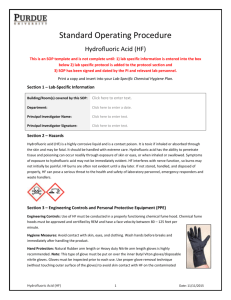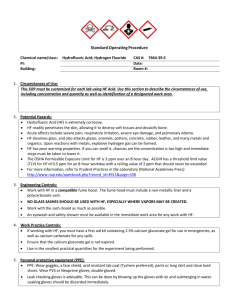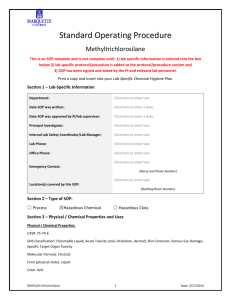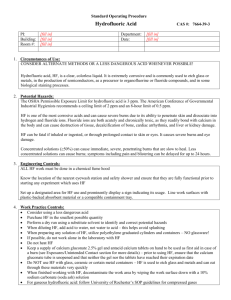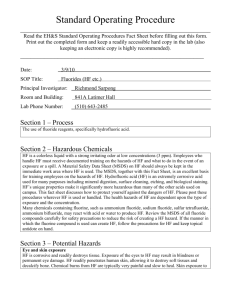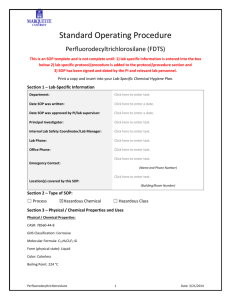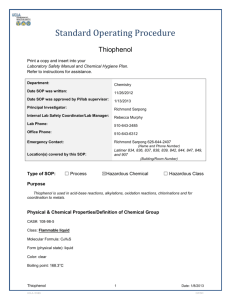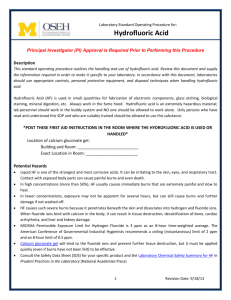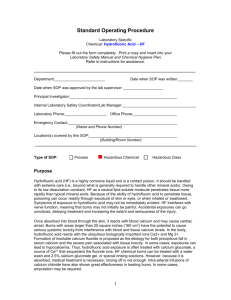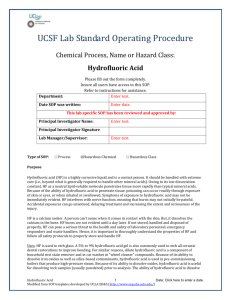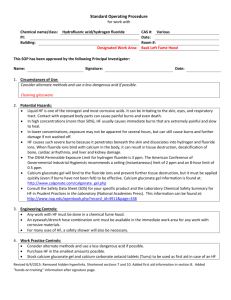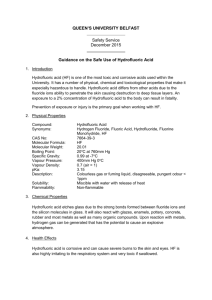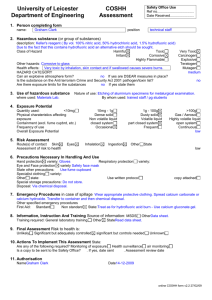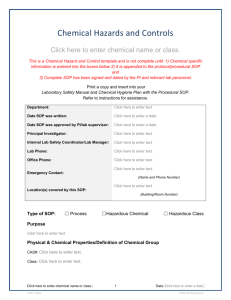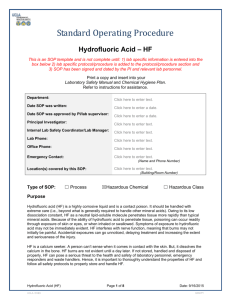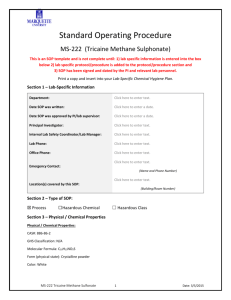Click here to enter text.
advertisement
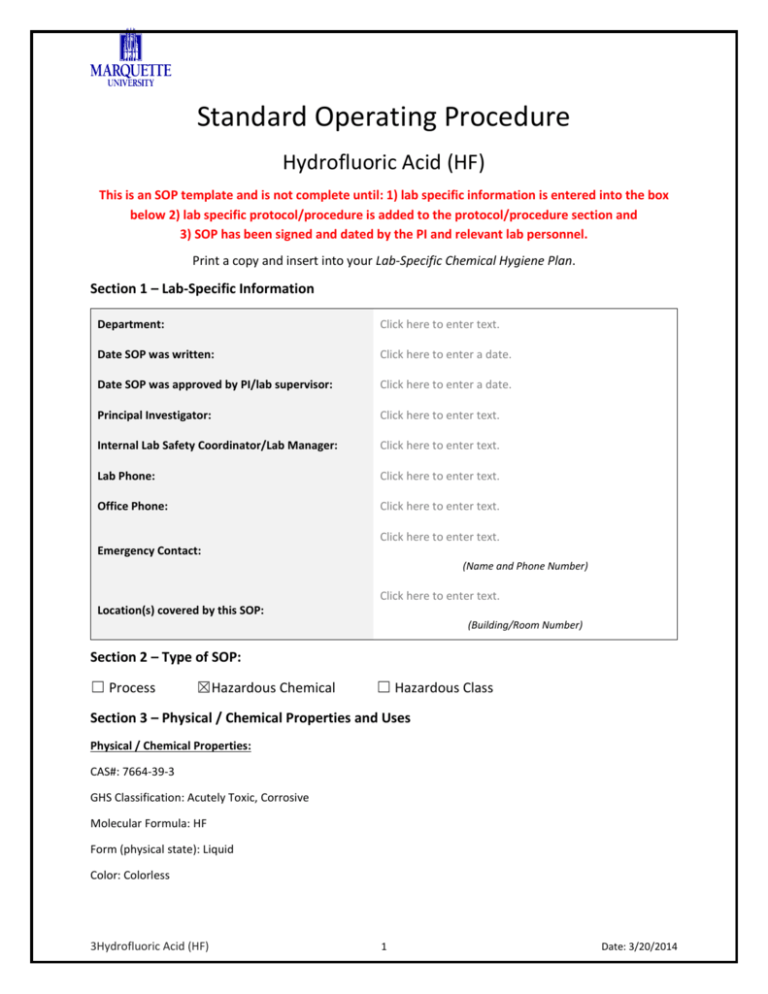
Standard Operating Procedure Hydrofluoric Acid (HF) This is an SOP template and is not complete until: 1) lab specific information is entered into the box below 2) lab specific protocol/procedure is added to the protocol/procedure section and 3) SOP has been signed and dated by the PI and relevant lab personnel. Print a copy and insert into your Lab-Specific Chemical Hygiene Plan. Section 1 – Lab-Specific Information Department: Click here to enter text. Date SOP was written: Click here to enter a date. Date SOP was approved by PI/lab supervisor: Click here to enter a date. Principal Investigator: Click here to enter text. Internal Lab Safety Coordinator/Lab Manager: Click here to enter text. Lab Phone: Click here to enter text. Office Phone: Click here to enter text. Click here to enter text. Emergency Contact: (Name and Phone Number) Click here to enter text. Location(s) covered by this SOP: (Building/Room Number) Section 2 – Type of SOP: ☐ Process ☒Hazardous Chemical ☐ Hazardous Class Section 3 – Physical / Chemical Properties and Uses Physical / Chemical Properties: CAS#: 7664-39-3 GHS Classification: Acutely Toxic, Corrosive Molecular Formula: HF Form (physical state): Liquid Color: Colorless 3Hydrofluoric Acid (HF) 1 Date: 3/20/2014 Boiling point: Not applicable Uses: HF is primarily used to etch glass. The strongest concentration typically seen from chemical manufacturers is a 48% aqueous solution. A 5% to 9% hydrofluoric acid gel is also commonly used to etch all ceramic dental restorations to improve bonding. For similar reasons, dilute hydrofluoric acid is a component of household rust stain remover and in car washes in "wheel cleaner" compounds. Because of its ability to dissolve iron oxides as well as silica-based contaminants, hydrofluoric acid is used in pre-commissioning boilers that produce high-pressure steam. Because of its ability to dissolve oxides, hydrofluoric acid is useful for dissolving rock samples (usually powdered) prior to analysis. The ability of hydrofluoric acid to dissolve metal oxides is the basis of several applications. It removes oxide impurities from stainless steel, a process called ‘pickling’, and silicon wafers in the semiconductor industry. Section 4 – Potential Hazards Hydrofluoric acid (HF) is a highly corrosive liquid and is a contact poison. It should be handled with extreme care (i.e., beyond what is generally required to handle other mineral acids). Owing to its low dissociation constant, HF as a neutral lipid-soluble molecule penetrates tissue more rapidly than typical mineral acids. Because of the ability of hydrofluoric acid to penetrate tissue, poisoning can occur readily through exposure of skin or eyes, or when inhaled or swallowed. Symptoms of exposure to hydrofluoric acid may not be immediately evident. HF interferes with nerve function, meaning that burns may not initially be painful. Accidental exposures can go unnoticed, delaying treatment and increasing the extent and seriousness of the injury. HF is a calcium seeker. A person cannot sense when it comes in contact with the skin. But it dissolves the calcium in the bone. HF burns are often not evident until a day later. If not stored, handled and disposed of properly, HF can pose a serious threat to the health and safety of laboratory personnel, emergency responders and waste handlers. Hence, it is important to thoroughly understand the properties of HF and follow all safety protocols to properly store and handle HF. Potential Health Effects: Inhalation Toxic if inhaled. Material is extremely destructive to the tissue of the mucous membranes and upper respiratory tract. Skin May be fatal if absorbed through skin. Causes skin burns. Eyes Causes eye burns. Causes severe eye burns. Ingestion May be fatal if swallowed. Section 5 – Personal Protective Equipment (PPE) Respirator Protection: Respirators should be used only under any of the following circumstances: 3Hydrofluoric Acid (HF) 2 Date: 3/20/2014 As a last line of defense (i.e., after engineering and administrative controls have been exhausted). When Permissible Exposure Limit (PEL) has exceeded or when there is a possibility that PEL will be exceeded. Regulations require the use of a respirator. An employer requires the use of a respirator. There is potential for harmful exposure due to an atmospheric contaminant (in the absence of PEL) As PPE in the event of a chemical spill clean-up process Lab personnel intending to use/wear a respirator mask must be trained and fit-tested. This is a regulatory requirement. Contact EH&S 8-8411 regarding respirator clearance. Hand Protection: Natural Rubber arm length or Heavy duty Nitrile arm length gloves is highly recommended. Note: This type of glove must be put on over the inner Butyl Viton gloves/disposable nitrile gloves. Gloves must be inspected prior to each use. Use proper glove removal technique (without touching outer surface of the gloves) to avoid skin contact with HF on the contaminated gloves. Dispose of inner nitrile gloves after use as hazardous waste. Inner Butyl Viton gloves can be reused carefully (i.e., without touching the outer surface of the gloves). Wash hands thoroughly with warm water and soap. NOTE: Consult with your preferred glove manufacturer to ensure that the gloves you plan on using are compatible with HF. Refer to glove selection chart from the links below: http://www.ansellpro.com/download/Ansell_8thEditionChemicalResistanceGuide.pdf OR http://www.showabestglove.com/site/default.aspx OR http://www.mapaglove.com/ Eye Protection: ANSI approved properly fitting safety goggles and face shield are required. Skin and Body Protection: Lab coat & natural rubber apron, full-length pants, and closed-toe rubber or leather shoes are required. NOTE: If HF is used in a cleanroom, the cleanroom gown will substitute for lab coat and full length pants. In addition, all the other PPE listed in this section is applicable. Hygiene Measures: Avoid contact with skin, eyes, and clothing. Wash hands before breaks and immediately after handling the product. 3Hydrofluoric Acid (HF) 3 Date: 3/20/2014 Section 6 – Engineering Controls HF can only be used in a properly functioning chemical fume hood or glove box. The chemical fume hood must be approved and certified by EH&S and have a face velocity between 85 – 125 feet per minute. Section 7 – First Aid Procedures First Aid Kit: All labs that store and use HF must have a HF First Aid Kit with the following supplies: Calcium Gluconate 2.5% Gel Milk of Magnesia Eyewash 1% Calcium Gluconate Solution NOTE: All three of these products expire and must be maintained (annual purchases must be made to keep the kit current) If inhaled: Dial 8-1911. Move to fresh air. If the person is not breathing, give artificial respiration. Avoid mouth to mouth contact. In case of skin contact: Dial 8-1911. Immediately (within seconds) flush affected area for at least 5 minutes. Remove all contaminated clothing. Wearing compatible gloves, massage calcium gluconate 2.5% gel into the affected area. Re-apply every 15 minutes until medical help arrives. NOTE: Hydrofluoric acid exposure is often treated with calcium gluconate, a source of Ca2+ that sequesters the fluoride ions. HF chemical burns can be treated with water and 2.5% calcium gluconate gel, or special rinsing solutions. However, because it is absorbed, medical treatment is necessary. Intraarterial infusions of calcium chloride have also shown great effectiveness in treating HF burns. In some cases, amputation has been required. In case of eye contact: Dial 8-1911. Flush eyes with water for 5 minutes. Then, use 1% Calcium Gluconate emergency eyewash solution. NOTE: Do not open the emergency eyewash solution seal unless it needs to be used. Use the entire 120 ml content during an emergency (eye exposure). Emergency eyewash solution is for single use only. If swallowed: Dial 8-1911. Do not induce vomiting. Drink large quantities of water then drink 12 ounces of milk of magnesia. Never give anything by mouth to unconscious person. Section 8 – Special Handling and Storage Requirements Ensure that you have all the PPE required for handling HF. HF must always be stored in plastic (nalgene / polypropylene) containers. Do not store HF in glass bottles/containers. Store in corrosive/acid/lab storage cabinet within a secondary containment (nalgene/ polypropylene tray or tub). 3Hydrofluoric Acid (HF) 4 Date: 3/20/2014 Do not store in the top most shelf of the storage cabinet. In general, do not store chemicals at or above eye level. Ensure the container is tightly closed at all times. Do not store with oxides, organic chemicals, bases or metals. Carefully carry the stock bottle in a rubber maid bottle carrier/nalgene secondary container to the wet bench/chemical fume hood and pour out desired amount into a smaller container. Place stock bottle back in corrosive chemical storage cabinet with cap tightly closed. Lab buddy system is highly recommended when handling HF. Lab emergency contact information must be readily available. The lab personnel must have easy access to a telephone (landline or cell phone). Section 9 – Spill and Accident Procedures Chemical Spill Dial 8-1911 Immediately evacuate area and ensure others are aware of the spill. If there is an imminent threat of a fire, pull the nearest fire alarm station to evacuate the building and dial 8-1911. If the spill is minor and does not pose a threat to personnel, contact EH&S at 8-8411 during normal business hours (7:30 AM – 4:30 PM) for spill cleanup assistance (dial 8-1911 if spill occurs after hours and assistance is needed). Chemical Spill on Body or Clothes: Remove clothing and begin first aid procedures (Section 7) immediately. Seek medical attention; dial 8-1911. Chemical Splash into Eyes: Immediately rinse eyes and begin first aid procedures (Section 7) immediately. Seek medical attention; dial 81911. Section 10 – Medical Emergency Life Threatening Emergency, After Hours, Weekends And Holidays: Dial 8-1911. Non-Life Threatening Emergency: Dial 8-1911. All HF exposures should be considered an emergency. Section 11 – Waste Disposal Procedures Label Waste: Make sure the waste container(s) is properly labeled; label should indicate all of the contents of the container. EH&S provides hazardous waste labels free of charge, contact dennis.daye@marquette.edu to obtain labels. Store Waste: Store hazardous waste in closed containers, and in a designated area (flammable cabinet is recommended). HF waste should be segregated from all incompatible chemicals such as caustics. 3Hydrofluoric Acid (HF) 5 Date: 3/20/2014 Dispose of Waste: Complete a Chemical Waste Pickup Request Form to arrange for disposal by EH&S. Contact dennis.daye@marquette.edu or visit the EH&S webpage for questions. http://www.marquette.edu/riskunit/environmental/documents/waste_disposal_form.pdf Section 12 – Safety Data Sheet (SDS) A current copy of the HF SDS must be made available to all personnel working in the laboratory at all times. To obtain a copy of the SDS, refer to Marquette’s MSDS library http://www.marquette.edu/riskunit/environmental/documents/msds_library.pdf or contact the chemical manufacturer. Many manufacturers’ SDSs can be found online on websites such as Sigma-Aldrich (http://www.sigmaaldrich.com/united-states.html) or Siri MSDS Index (http://hazard.com/msds/). Section 13 – Protocol/Procedure (Add lab specific Protocol/Procedure here) Click here to enter text. NOTE: Any deviation from this SOP requires approval from PI. Section 14 – Documentation of Training (signature of all users is required) Prior to conducting any work with HF, designated personnel must provide training to his/her laboratory personnel specific to the hazards involved in working with this substance, work area decontamination, and emergency procedures. The Principal Investigator must provide his/her laboratory personnel with a copy of this SOP and a copy of the SDS provided by the manufacturer. The Principal Investigator must ensure that his/her laboratory personnel have attended appropriate laboratory safety training or refresher training within the last one year. I have read and understand the content of this SOP: Name Signature Date Click here to enter text. Click here to enter a date. Click here to enter text. Click here to enter a date. Click here to enter text. Click here to enter a date. Click here to enter text. Click here to enter a date. 3Hydrofluoric Acid (HF) 6 Date: 3/20/2014 Name Signature Date Click here to enter text. Click here to enter a date. Click here to enter text. Click here to enter a date. Click here to enter text. Click here to enter a date. Click here to enter text. Click here to enter a date. Click here to enter text. Click here to enter a date. Click here to enter text. Click here to enter a date. Click here to enter text. Click here to enter a date. Click here to enter text. Click here to enter a date. Click here to enter text. Click here to enter a date. Click here to enter text. Click here to enter a date. Click here to enter text. Click here to enter a date. Click here to enter text. Click here to enter a date. Click here to enter text. Click here to enter a date. 3Hydrofluoric Acid (HF) 7 Date: 3/20/2014
